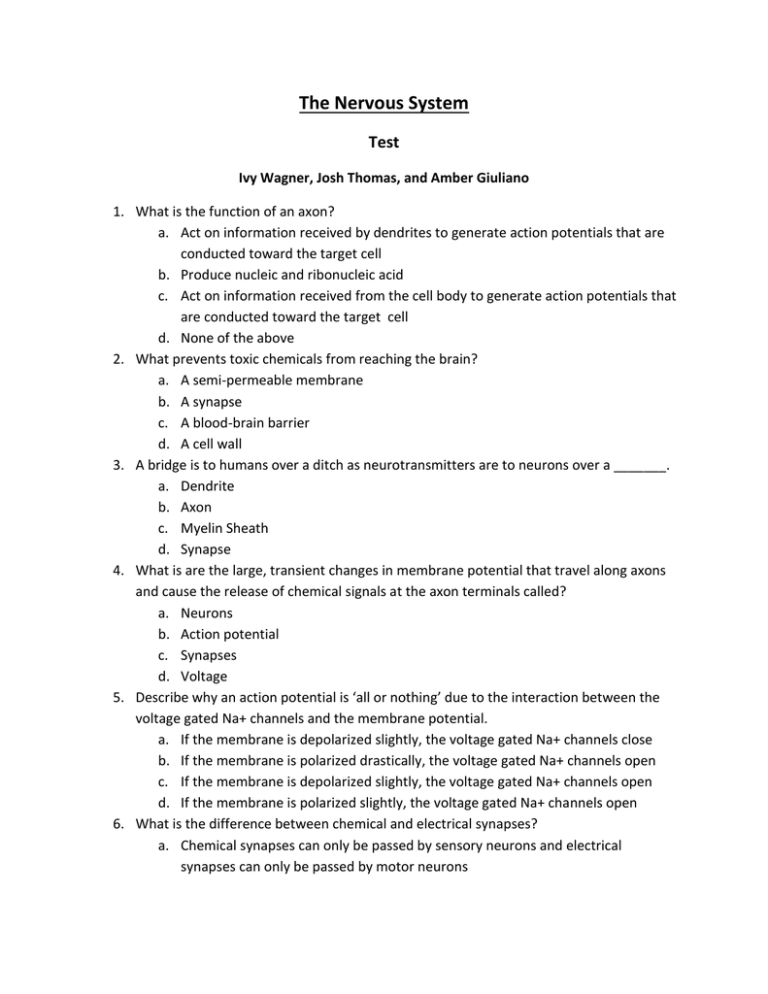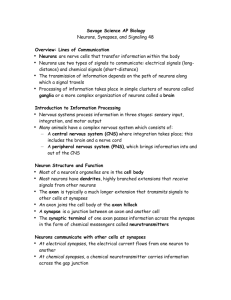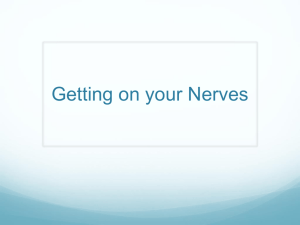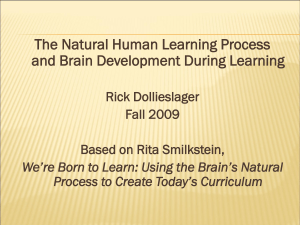File - The Nervous System
advertisement

The Nervous System Test Ivy Wagner, Josh Thomas, and Amber Giuliano 1. What is the function of an axon? a. Act on information received by dendrites to generate action potentials that are conducted toward the target cell b. Produce nucleic and ribonucleic acid c. Act on information received from the cell body to generate action potentials that are conducted toward the target cell d. None of the above 2. What prevents toxic chemicals from reaching the brain? a. A semi-permeable membrane b. A synapse c. A blood-brain barrier d. A cell wall 3. A bridge is to humans over a ditch as neurotransmitters are to neurons over a _______. a. Dendrite b. Axon c. Myelin Sheath d. Synapse 4. What is are the large, transient changes in membrane potential that travel along axons and cause the release of chemical signals at the axon terminals called? a. Neurons b. Action potential c. Synapses d. Voltage 5. Describe why an action potential is ‘all or nothing’ due to the interaction between the voltage gated Na+ channels and the membrane potential. a. If the membrane is depolarized slightly, the voltage gated Na+ channels close b. If the membrane is polarized drastically, the voltage gated Na+ channels open c. If the membrane is depolarized slightly, the voltage gated Na+ channels open d. If the membrane is polarized slightly, the voltage gated Na+ channels open 6. What is the difference between chemical and electrical synapses? a. Chemical synapses can only be passed by sensory neurons and electrical synapses can only be passed by motor neurons b. Chemical synapses induce changes in the postsynaptic cell while electrical synapses join the cytoplasms of pre and post synaptic cells c. Electrical synapses are connections from a terminal branch to a dendrite while chemical synapses are connections between neurons d. Electrical synapses can only be passed by sensory neurons and chemical synapses can only be passed by motor neurons 7. Where are the terminals of motor neurons found? a. Motor end plate b. Nucleus c. Cell membrane d. Synapses 8. Other than by vertebrate neuron systems, where is acetylcholine used? a. Pancreas b. Heart c. Liver d. Brain 9. Where are most of the cells of the nervous system found? a. Brain b. Spinal Cord c. Both a and b d. None of the above 10. What are the two divisions of the autonomic nervous system? a. Systematic and anti-systematic b. Sensory Neurons and Motor neurons c. Sympathetic and Parasympathetic d. Autonomic and somatic 11. What is an example of a monosynaptic reflex? a. Knee-jerk reflex b. Fight or flight reaction c. Sleep d. Heartbeat 12. Psychologists would most likely be most interested in which part of the brain? a. Diencephalon b. Hypothalamus c. Thalamus d. Telencephalon 13. If someone has a disorder of the amygdale, they most likely have problems with what? a. Pain reactions and management b. Memory storage c. Speech d. Fear reactions and memory 14. What is the purpose of convolutions? a. Increase surface area b. Speed up transformation of DNA c. Send and receive neural impulses d. Increase action potential 15. Why do the resting potentials of the cells of the thalamus and cortex become more negative and less sensitive to excitatory synaptic input with the onset of sleep? a. Your heart beat slows- as does the function speed of your brain b. A decrease of adrenaline in the brain slows reaction time c. Brainstem neurons release less neurotransmitters d. Synaptic gaps become too large to cross 16. What pathway(s) does the brain inhibit during REM sleep? a. Autonomic and somatic b. Sensory and nervous c. Nervous and circulatory d. Afferent and efferent 17. A woman that is unable to see motion has most likely received damage to which part of her brain? a. Temporal b. Occipital c. Parietal d. Frontal 18. Patients that damage Broca’s area most likely encounter problems concerning: a. Memory b. Speech c. Language d. Motor Skills 19. Why might we have trouble awakening from a nightmare even when we realize we are dreaming during REM sleep? a. Your brain doesn’t coherently make decisions during REM sleep b. REM sleep only occurs in patents experiencing comas c. We are paralyzed d. We are perfectly content throughout the REM cycle 20. What is the function of the insula? a. Creates a sensation of how the body ‘feels’ b. Generate the production of insulin within the body c. Regulates the digestive tract d. Processes and manages fear 21. Describe gated ion channels and their functions. Be sure to include the words voltagegates channels, chemically controlled voltage, and mechanically gated channels. 22. Describe how learning and memory are related and how they involve changes.






